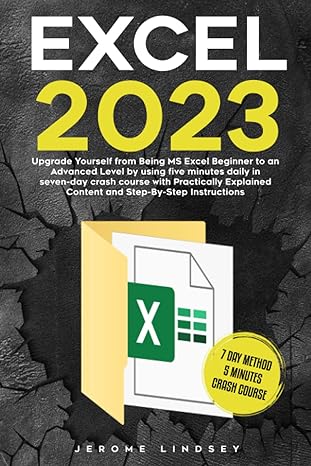Question
Introduction: Every physics student has had a lot of experience with the force of gravity. Unfortunately, this experience is limited to the interaction between a
Introduction:
Every physics student has had a lot of experience with the force of gravity.
Unfortunately, this experience is limited to the interaction between a very large object, the
Earth, and much smaller objects that are very close to it. This is a
very limited range of the
possibilities. Software simulations of gravity allow physics students to explore a variety of other
gravitational interactions between objects. These activities are designed to be used with the
JAVA applet My Solar System that ca
n be found on the Physics Education Technology (PhET)
website at the University of Colorado at Boulder.
Procedure
:
Go to the My Solar System simulation on the PhET website and carefully follow the
instructions for each activity. Answer the questions and
record your results before going on to
the next activity. The simulation can be found at this URL:
http://phet.colorado.edu/sims/my
-
solar
-
system/my
-
solar
-
system.swf
Activity
A:
Look over the start screen. The simulations controls and settings are on the right and
simulation inputs are at the bottom. Click on Start to see the outputs in the center and lower
right. The paths of the objects in the simulation are displayed alon
g with elapsed time. Click
Stop and move the cursor over each object. Its current position and velocity are displayed
under the time.
Click the Show Grid box and make sure that System Centered and Show Traces are checked too.
Drag the slider bar all the w
ay to the left for the most accuracy. Click Reset, then change Body
1s mass to 500 and its and
position and velocity to 0. Change Body 2s mass to 30, its
position to 200, and position and
and
velocity to zero. Reset must always be clicked
before changing position and velocity of the current simulation. Write down your prediction for
the motion of both Bodies below before clicking Start to find out.
Body 1 (Yellow) motion:
Body 2 (Purple) motion:
1.
Were your predictions correct? How many d
istance units does one square of the grid
represent? Click and drag on the lower right corner of the window to make it 10 grids wide.
2.
Change Body 2s mass to 0.001. Click Start again. What is different about the result? Why
do you think this is?
3.
What sh
ould be the direction of Body 2s initial velocity so that it doesnt ever hit Body 1?
Project
Caliper
Gravity Simulations
Page
2
4.
Increase Body 2s
velocity by increments of 10 until it doesnt touch Body 1. At what
velocity does this first happen? What is the shape of the resulting orbit? Descr
ibe Body 2s
speed near Body 1 and when it is far from Body 1.
5.
Continue to increase Body 2s velocity until the orbit has a circular shape. Using the grid,
adjust it by increments of 1 until it is as close to a perfect circle as you can get. What
velocity
resulted in a circle? Is the speed of Body 2 constant? Stop it as it crosses the grid on
the opposite side and place the cursor over it to verify.
6.
Is the velocity of Body 2 constant? Explain.
Activity B:
Draw a free
-
body diagram of Body 2 in its circular orbit below. Using Newtons Second
Law, the Law of Gravity, and the equation for centripetal acceleration, derive an expression for
the Universal Gravitational Constant,
. Using the values from the simul
ation, solve for the
value of
used in the simulation. Show ALL of your work below. Verify your result with your
instructor before going on.
=
7.
Use your equation from above to derive an equation for the speed of an object in a circular
orbit. Using this equation and your value for
, solve for the speed required for a third body
to be in a circular orbit with a radius of 100. Show all of your wor
k and your final answer
below.
8.
Click Reset and change the
velocity of Body 2 to 250. What happens to Body 2? Why?
What shape is its trajectory?
9.
Using conservation of energy and the fact that a body moving at escape velocity has zero
kinetic energy f
ar from the other mass, find the escape velocity from a given mass at a given
radius, starting at rest. What would the escape velocity be for Body 2 using the value of
found in Q6
?
Step by Step Solution
There are 3 Steps involved in it
Step: 1

Get Instant Access to Expert-Tailored Solutions
See step-by-step solutions with expert insights and AI powered tools for academic success
Step: 2

Step: 3

Ace Your Homework with AI
Get the answers you need in no time with our AI-driven, step-by-step assistance
Get Started


